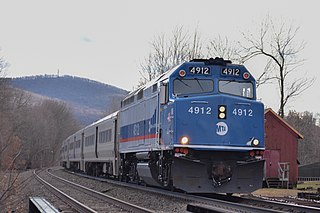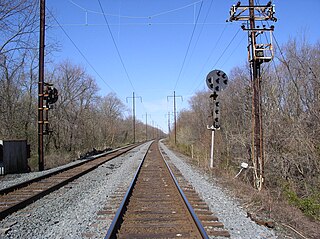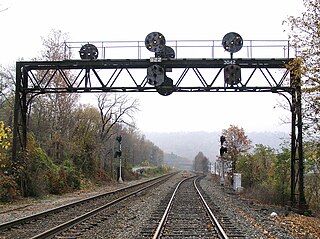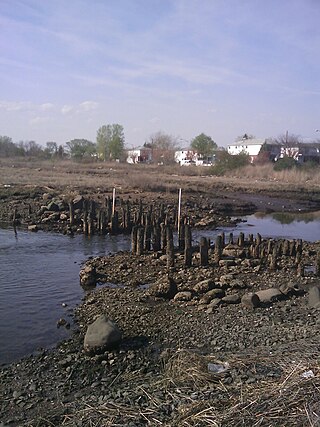
The New York Central Railroad was a railroad primarily operating in the Great Lakes and Mid-Atlantic regions of the United States. The railroad primarily connected greater New York and Boston in the east with Chicago and St. Louis in the Midwest, along with the intermediate cities of Albany, Buffalo, Cleveland, Cincinnati, Detroit, Rochester and Syracuse. New York Central was headquartered in New York City's New York Central Building, adjacent to its largest station, Grand Central Terminal.
The Erie Railroad was a railroad that operated in the Northeastern United States, originally connecting Pavonia Terminal in Jersey City, New Jersey, with Lake Erie at Dunkirk, New York. The railroad expanded west to Chicago following its 1865 merger with the former Atlantic and Great Western Railroad, also known as the New York, Pennsylvania and Ohio Railroad.

The Delaware, Lackawanna and Western Railroad, also known as the DL&W or Lackawanna Railroad, was a U.S. Class 1 railroad that connected Buffalo, New York, and Hoboken, New Jersey, and by ferry with New York City, a distance of 395 miles (636 km). The railroad was incorporated in Pennsylvania in 1853, and created primarily to provide a means of transport of anthracite coal from the Coal Region in Northeast Pennsylvania to large coal markets in New York City. The railroad gradually expanded both east and west, and eventually linked Buffalo with New York City.

The Bergen County Line is a commuter rail line and service owned and operated by New Jersey Transit in the U.S. state of New Jersey. The line loops off the Main Line between the Meadowlands and Glen Rock, with trains continuing in either direction along the Main Line. It is colored on NJT system maps in grey, and its symbol is a cattail, which are commonly found in the Meadowlands where the line runs.
The Lake Shore Subdivision is a former subdivision of a railroad line owned by CSX Transportation in the U.S. states of New York and Pennsylvania.

The Port Jervis Line is a predominantly single-track commuter rail line running between Suffern and Port Jervis, in the U.S. state of New York. At Suffern, the line continues south into New Jersey on NJ Transit's Main Line. The line is operated by NJ Transit Rail Operations under a contract with Metro-North Railroad (MNRR).
The Keystone Subdivision is a railroad line owned and operated by CSX Transportation in the U.S. states of Maryland and Pennsylvania. The line runs from Cumberland, Maryland, west to McKeesport, Pennsylvania, along a former Baltimore and Ohio Railroad (B&O) line. The line includes the well-known Sand Patch Grade over the Allegheny Mountains.

The Trenton Subdivision is a railroad line owned by CSX Transportation in the U.S. states of Pennsylvania and New Jersey. The line runs from CP NICE in Philadelphia, Pennsylvania, northeast to Port Reading Junction in Manville, New Jersey. The line was formerly part of the Reading Company system.
The Rochester Subdivision is a railroad line owned by CSX Transportation in the U.S. state of New York. The line runs from Solvay, New York, west to Churchville, New York, along the former New York Central Railroad water level route. At its east end, west of downtown Syracuse, New York, the line continues west from the Syracuse Terminal Subdivision at Control Point (CP)-296. It intersects the West Shore Subdivision, which provides a southern bypass of Rochester, at Fairport (CP-359) and Churchville (CP-382). At its west end in Churchville the line becomes the Buffalo Terminal Subdivision.

The Enola Branch is a rail line segment of the Port Road Branch and was a rail line. The Enola Branch rail line segment and the rest of the Port Road Branch is owned and operated by the Norfolk Southern Railway in the U.S. state of Pennsylvania. The rail line segment runs from Washington Boro northwest to Marysville and it is a former Pennsylvania Railroad rail line. Its south end is at a former junction with the Atglen and Susquehanna Branch, where the main segment of the Port Road Branch continues southeast. Its north end is at the Pittsburgh Line. Along the way, it meets the York Secondary at Wago Junction and goes under the Lurgan Branch at Lemoyne. Norfolk Southern labels the Enola Branch as part of the Port Road Branch, officially ending the Enola Branch's existence as a rail line, the main segment of the Port Road Branch runs from Marysville south to Perryville, Maryland. The line goes through the Enola Yard.

The Buffalo Line is a railroad line owned by the Norfolk Southern Railway in the U.S. states of New York and Pennsylvania. The line runs from Buffalo, New York southeast to Rockville, Pennsylvania near Harrisburg, Pennsylvania along a former Pennsylvania Railroad line. Its north end is at Seneca Yard in Buffalo, with no direct access to the Lake Erie district, and its south end is at the Pittsburgh Line at Rockville. The line is operated by the Buffalo and Pittsburgh Railroad between Buffalo and Machias, New York, the Western New York and Pennsylvania Railroad between Machias and Driftwood, Pennsylvania, and the Norfolk Southern Railway between Driftwood and Rockville.
The Sunbury Line, formerly known as Sunbury Subdivision, is a rail line owned and operated by Norfolk Southern Railway which in turn is owned by the Norfolk Southern Corporation. The line travels from Sunbury, Pennsylvania, to Binghamton, New York, connecting with Norfolk Southern's Southern Tier Line at Binghamton and Norfolk Southern's Buffalo Line at Sunbury.

The Main Line of the Pennsylvania Railroad was a rail line in Pennsylvania connecting Philadelphia with Pittsburgh via Harrisburg. The rail line was split into two rail lines, and now all of its right-of-way is a cross-state corridor, composed of Amtrak's Philadelphia to Harrisburg Main Line and the Norfolk Southern Railway's Pittsburgh Line.
The New Castle Branch was a rail line owned and operated by the Pennsylvania Railroad in the U.S. state of Pennsylvania. The line ran from New Castle north to Stoneboro, and is now entirely abandoned. At its south end, the line intersected the Erie and Pittsburgh Branch and Mahoningtown Branch. When the New Castle Branch ended at Stoneboro, the PRR had trackage rights east along the New York Central Railroad's Stoneboro Branch to Oil City and the Allegheny Branch, Chautauqua Branch, and Salamanca Branch.
The Pittsburgh to St. Louis Main Line was a rail line owned and operated by the Pennsylvania Railroad in the U.S. states of Pennsylvania, Ohio, Indiana, and Illinois. The line ran from Pittsburgh, Pennsylvania west via Steubenville, Ohio, Columbus, Ohio, Dayton, Ohio, Indianapolis, Indiana, Terre Haute, Indiana, and Vandalia, Illinois to East St. Louis, Illinois. In addition to its east end in downtown Pittsburgh, where it met the Main Line and Pittsburgh to Chicago Main Line, junctions included the Columbus to Chicago Main Line at Columbus, the C&X Branch at Xenia, the Columbus to Indianapolis Main Line via Bradford at New Paris, the Richmond Branch and Fort Wayne Branch at Richmond, the Louisville Branch and I&F Branch at Indianapolis, and the Peoria Branch at Farrington, Illinois.
The South Side Railroad of Long Island was a railroad company in the U.S. state of New York. Chartered in 1860 and first opened in 1867 as a competitor to the Long Island Rail Road, it was reorganized in 1874 as the Southern Railroad of Long Island and leased in 1876 to the LIRR. After a reorganization as the Brooklyn and Montauk Railroad in 1879 it was merged in 1889.

The Cedarhurst Cut-off was a rail line owned and operated by the Long Island Rail Road in the U.S. state of New York. The line split from the LIRR's Main Line at Rockaway Junction and ran south via Springfield Gardens and Cedarhurst and on to Far Rockaway. The part north of the crossing of the old Southern Railroad of Long Island at Springfield Junction is now part of the Montauk Branch, while the rest has been abandoned in favor of the ex-Southern Far Rockaway Branch.

The Central New York Railroad is a shortline railroad operating local freight service along ex-Southern Tier Line trackage in New York and Pennsylvania.

The Western New York and Pennsylvania Railroad is a short-line railroad that operates freight trains in Western New York and Northwest Pennsylvania. The company is controlled by the Livonia, Avon and Lakeville Railroad, with which it does not connect. It started operations in 2001 on the Southern Tier Extension, a former Erie Railroad line between Hornell, New York and Corry, Pennsylvania, owned by the public Chautauqua, Cattaraugus, Allegany and Steuben Southern Tier Extension Railroad Authority (STERA).











